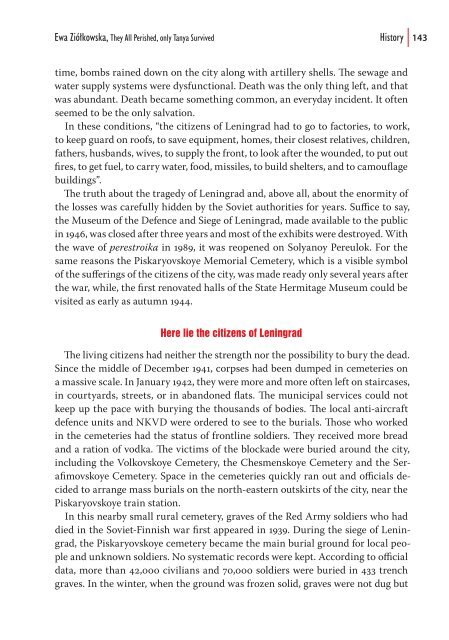You also want an ePaper? Increase the reach of your titles
YUMPU automatically turns print PDFs into web optimized ePapers that Google loves.
Ewa Ziółkowska, They All Perished, only Tanya Survived History 143<br />
time, bombs rained down on the city along with artillery shells. Th e sewage and<br />
water supply systems were dysfunctional. Death was the only thing left, and that<br />
was abundant. Death became something common, an everyday incident. It often<br />
seemed to be the only salvation.<br />
In these conditions, “the citizens of Leningrad had to go to factories, to work,<br />
to keep guard on roofs, to save equipment, homes, their closest relatives, children,<br />
fathers, husbands, wives, to supply the front, to look after the wounded, to put out<br />
fi res, to get fuel, to carry water, food, missiles, to build shelters, and to camoufl age<br />
buildings”.<br />
Th e truth about the tragedy of Leningrad and, above all, about the enormity of<br />
the losses was carefully hidden by the Soviet authorities for years. Suffi ce to say,<br />
the Museum of the Defence and Siege of Leningrad, made available to the public<br />
in 1946, was closed after three years and most of the exhibits were destroyed. With<br />
the wave of perestroika in 1989, it was reopened on Solyanoy Pereulok. For the<br />
same reasons the Piskaryovskoye Memorial Cemetery, which is a visible symbol<br />
of the suff erings of the citizens of the city, was made ready only several years after<br />
the war, while, the fi rst renovated halls of the State Hermitage Museum could be<br />
visited as early as autumn 1944.<br />
Here lie the citizens of Leningrad<br />
Th e living citizens had neither the strength nor the possibility to bury the dead.<br />
Since the middle of December 1941, corpses had been dumped in cemeteries on<br />
a massive scale. In January 1942, they were more and more often left on staircases,<br />
in courtyards, streets, or in abandoned fl ats. Th e municipal services could not<br />
keep up the pace with burying the thousands of bodies. Th e local anti-aircraft<br />
defence units and NKVD were ordered to see to the burials. Th ose who worked<br />
in the cemeteries had the status of frontline soldiers. Th ey received more bread<br />
and a ration of vodka. Th e victims of the blockade were buried around the city,<br />
including the Volkovskoye Cemetery, the Chesmenskoye Cemetery and the Serafi<br />
movskoye Cemetery. Space in the cemeteries quickly ran out and offi cials decided<br />
to arrange mass burials on the north-eastern outskirts of the city, near the<br />
Piskaryovskoye train station.<br />
In this nearby small rural cemetery, graves of the Red Army soldiers who had<br />
died in the Soviet-Finnish war fi rst appeared in 1939. During the siege of Leningrad,<br />
the Piskaryovskoye cemetery became the main burial ground for local people<br />
and unknown soldiers. No systematic records were kept. According to offi cial<br />
data, more than 42,000 civilians and 70,000 soldiers were buried in 433 trench<br />
graves. In the winter, when the ground was frozen solid, graves were not dug but



